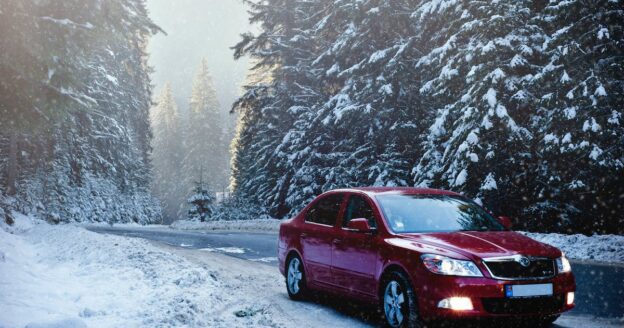As the temperatures drop and the days grow shorter, it’s time to prepare your vehicle for the long and harsh winter season. Winterizing your vehicle is not just about ensuring your comfort on the road. It’s also a crucial step in maintaining safety on icy roads and in harsh weather conditions.
Below is a comprehensive guide to winterizing your vehicle, ensuring you stay on the road with confidence during the coldest months of the year.
Check Your Fluids
One of the first steps in winterizing your vehicle is to check and change essential fluids. Make sure that your oil, coolant and windshield washer fluid are at the recommended levels. You can check them at home or at your next oil change. If you have an oil change scheduled, make sure all fluids are topped off. Also, consider using a winter-grade windshield washer fluid that won’t freeze in cold temperatures.
Inspect Your Tires
Your tires are the only point of contact between your vehicle and the road, making them crucial for winter safety. Check the tread depth and tire pressure regularly. Tire treads that are below 1.6 millimeters lack grip and will interfere with your braking and control. If this is the case, consider investing in winter tires, designed to provide better traction in snow and icy conditions.
Battery Health
Cold weather can be tough on your vehicle’s battery, especially if you leave it parked outside. Check the battery’s charge and clean any corrosion on the terminals. If your battery is more than three years old, consider having it tested or replaced. Fortunately, car batteries are fairly inexpensive and can be installed on your own.
Heating and Defrosting Systems
Ensure that your heating and defrosting systems are in proper working condition. You don’t want to find out that your heater isn’t working on a freezing morning as many of us unfortunately do! Also, check your window defrosters and replace any malfunctioning components.
Brake Inspection
Brakes are critical for winter driving safety. Have your brakes inspected to ensure they are in good condition. Any type of squealing or grinding can indicate brake problems, and you don’t want these when you’re driving on snowy or icy roads. Replace worn brake pads and make sure your brake fluid is at the recommended level as well.
Emergency Kit
Create or update your winter emergency kit. Include items such as a blanket, extra clothing, non-perishable snacks, a flashlight and a first aid kit. Also, consider adding a small shovel and ice scraper to help you handle unexpected winter weather challenges.
Engine Block Heater
If you live in an extremely cold climate, consider using an engine block heater. This device warms the engine, making it easier to start in frigid temperatures. It can also improve fuel efficiency during short trips in the cold.
Check Lights and Wipers
Visibility is crucial during winter driving. Test all your lights to make sure they are working correctly, including headlights, brake lights and turn signals. Replace any burnt-out bulbs – this is a DIY job and not too expensive. Additionally, check and replace worn wiper blades to maintain clear visibility.
Keep the Fuel Tank Full
We know that gas prices are expensive, but try to keep your fuel tank at least half full during the winter months. This prevents the fuel line from freezing and provides extra weight over the rear axle, improving traction in slippery conditions.
Regular Maintenance
Lastly, adhere to your vehicle’s regular maintenance schedule. A well-maintained vehicle is more likely to handle the challenges of winter driving. Regular oil changes, air filter replacements and other routine maintenance tasks will keep your vehicle in good condition.
Get Your Car Ready for Winter
Winterizing your vehicle is an investment in both safety and peace of mind during the coldest months of the year. By following these tips, you’ll be better prepared to navigate winter roads and ensure a smooth and secure journey.
If you don’t think your car can handle another winter, visit RepoFinder.com. We provide an organized directory of links to banks, lenders and credit unions that are selling their repo inventory. You can find great cars at great prices – and you won’t have to fear your vehicle breaking down at the worst time!

